Nothing but a Big Circus
When I was a kid, getting my horse on the trailer always turned into a huge tug-of-war. I’d ask her to step onto the trailer, and she’d fight the halter, rear and back up. My entire family would get involved; we’d run a rope behind her butt and try to push her on the trailer. We tried bribing her on with treats. We yelled at her and waved our arms and stomped our feet. There’d be dogs and three or four big rednecks swearing and cussing. The whole ordeal would turn into nothing but a big circus.
For a long time, I thought that was just how getting a horse on the trailer was. You were either lucky and your horse went on a trailer, or you were unlucky and your horse didn’t go on. That seemed to be the case everywhere I went.
It wasn’t until I did my first horsemanship clinic with Gordon McKinlay that I realized how wrong I was. During the clinic, Gordon demonstrates how to load a horse in a trailer. and, more importantly, how to make the horse want to get on the trailer. It blew my mind. Not only could I teach my horse how to confidently load on a trailer; I could get her to crave to be on the trailer.
After the clinic, I went home and practiced getting my horse to load on the trailer. Sure enough, I got the same results Gordon did. I was so thrilled that I could get a 1,000-pound animal to willingly do something that she had previously been afraid to do.
What Gordon taught me was to look at trailering from the horse’s perspective. As prey animals, with a flight or fight response, horses prefer to be in big, open spaces where they can easily see predators approaching them and then be able to make a quick getaway. You’ll never see a prey animal having a rest in a tight, narrow space because if a predator came along, he’d be trapped. That’s why, as a general rule, horses don’t like trailers—they make them feel trapped and claustrophobic.
Not only do trailers make horses feel trapped and claustrophobic, but they’re also a scary object. Horses hate objects. What is an object? An object is anything that doesn’t live in your horse’s stall or pasture. Why is it no longer an object if it lives in your horse’s stall or pasture? Because if it lives in your horse’s stall or pasture, your horse sees it every day and gets desensitized to it. Horses especially hate objects that move and make a noise. A trailer does a little bit of everything. It’s an object, it moves, and it makes a noise when the horse walks up on it and as it’s traveling down the road.
If you put yourself in your horse’s shoes, trailering can be a traumatic experience, especially when the horse doesn’t understand that the trailer isn’t going to hurt him.
Something Bigger
After practicing Gordon’s trailer loading method on my horse, and once I had my family’s horses craving to be on the trailer, I started traveling around the countryside, practicing on all the horses I could get my hands on. I practiced on my neighbors’ horses, my friends’ horses and my cousins’ horses. After about six months of practicing on all the horses I could find, I actually started to get pretty good at loading horses onto trailers.
“ If you put yourself in your horse’s shoes, trailering can be a traumatic experience, especially when the horse doesn’t understand that the trailer isn’t going to hurt him.”
I decided that I could start to make some money off of my newfound skill. With my parents’ help, I put an ad in the local newspaper stating that for $50 I could get any horse to load on a trailer. For the two years that I was in high school, that’s how I made money. I would travel around to local horse shows and events and offer my services to anyone who needed them.
As I was traveling around and teaching horses to load on trailers, I began to notice that 99 percent of people who had trailering problems with their horses fell into one of two categories. Their horse’s trailering problem was either based on fear or a lack of respect. More than anything, I saw a total lack of respect, and that holds true even today. Nearly all the horses that come to tours for the trailer loading demo don’t have a trailering problem; they have a lack of respect that shows up when they are asked to step on a trailer. In reality, all problems we have with our horses are nothing more than symptoms of a cause. That goes for trailering, biting, bucking, kicking, etc. Fix the cause, which in most cases is disrespect, and the problem will disappear.
That’s why when we get horses in for the Academy Horse Program that have a trailering problem, we never try to load them in the trailer immediately. Instead, we start the Fundamentals with them. We spend a few weeks working on groundwork and building their respect. Trailer loading is the last thing we introduce to the horses, because at that point in their training, once we have the horses’ respect, it takes all of two minutes to get them confidently stepping on and off the trailer.
Before working on a trailering problem, be sure you have the Fundamentals groundwork exercises done well. Can you still get results with the steps I describe in this article if your horse doesn’t know the Fundamentals? Yes. More than likely, you’ve seen me do it at a tour. However, if you’ve got a solid foundation, the process will go smoothly and be less stressful to the horse.
How to Load a Horse in a Trailer: Teaching Stage
Your goal is to send the horse between you and the trailer in a four-foot gap. However, if your horse is truly scared of the trailer, you may have to start by sending him 20 feet away from it. That’s OK. Find a starting point your horse is comfortable with, and then gradually decrease the distance between you and the trailer. Each time you send him from one side of your body to the other, he’ll build a little more confidence.
It’s important to work the horse on all three sides of the trailer because a lot of horses try to avoid the trailer by running around to the side. By doing the Sending Exercise all around the trailer, you’re proving to the horse that it doesn’t matter where he goes; you can always control his feet.


1. Start by making sure your horse is comfortable around the trailer. If he’s not comfortable around the trailer, he’s not going to want to go inside it. Using the Sending Exercise from the Fundamentals Series, move the horse’s feet around all three sides of the trailer.
Act like you’re just practicing some groundwork with your horse and the trailer happens to be near you. The more you act like you’re doing a trailer loading session, the more worried the horse will get. The more you act like it’s not there, the quicker he’ll relax and focus on you.
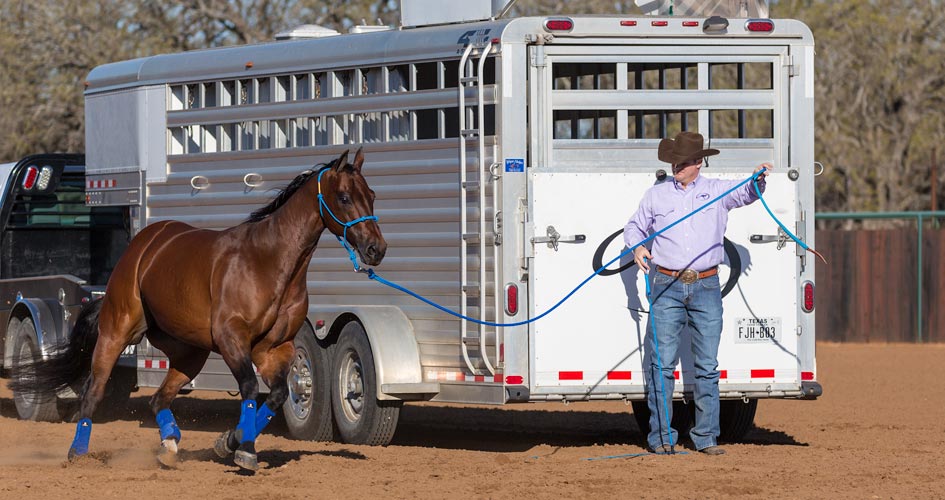
2. After you’ve practiced the Sending Exercise on all three sides of the trailer, it’s time to give your horse one final test to see how much control of his feet you truly have. Stand at the rear of the trailer so that your back is against the door. Then send the horse from one side of the trailer to the other without moving your feet. You’ll do this by pointing in the air with the lead rope in the direction you want the horse to go in. If you have earned the horse’s respect and you can control his feet, he should come off the halter pressure when you point and readily move his feet. If he doesn’t, use your Handy Stick to create pressure behind his drive line to encourage him to move forward.
If you can’t do this with your horse, you need to practice more of the Sending Exercise on all three sides of the trailer before moving on to the next step.
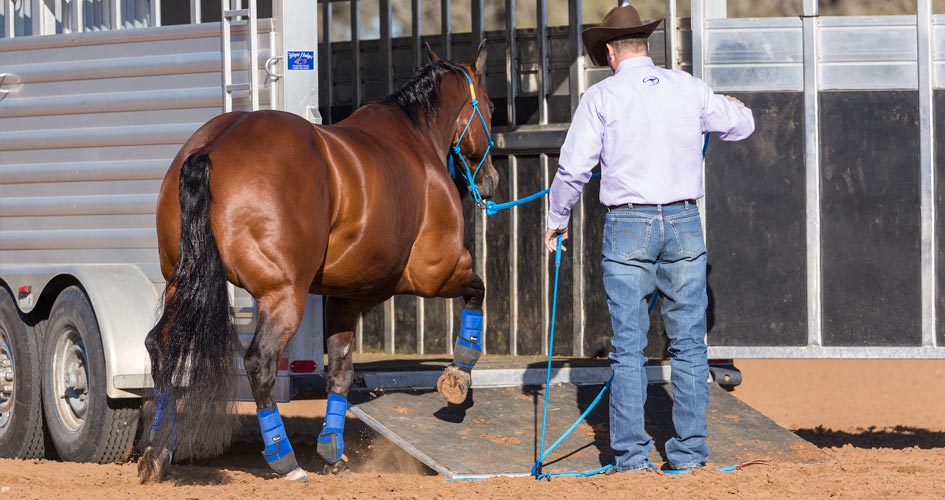
3. Lower the ramp of the trailer. If your trailer doesn’t have a ramp, you can either skip this step or construct a safe, sturdy “ramp” out of plywood and 2x4s to simulate the motion of stepping up onto something that moves and makes a noise.
Once you have the ramp lowered, start out by sending the horse between you and the ramp. Since you’ve already established control of his feet earlier, he shouldn’t be too worried about this step. However, keep in mind that if the horse has had problems with trailers in the past, he’s going to start to get suspicious when you lower the ramp. If he gets nervous, keep his feet moving and his attention on you.
Then ask the horse to step onto the ramp. This step will help the horse get used to the noise he’ll hear when he walks up the trailer and to the movement he’ll feel under his feet.
If you skip this step and go straight to asking the horse to step onto the trailer, the first time he hears that noise and feels the trailer move under his feet, he’ll panic. In the horse’s mind, when you load him on the trailer, you’re leading him into a narrow, dark cave. Don’t make the experience any scarier for him than what it already is.
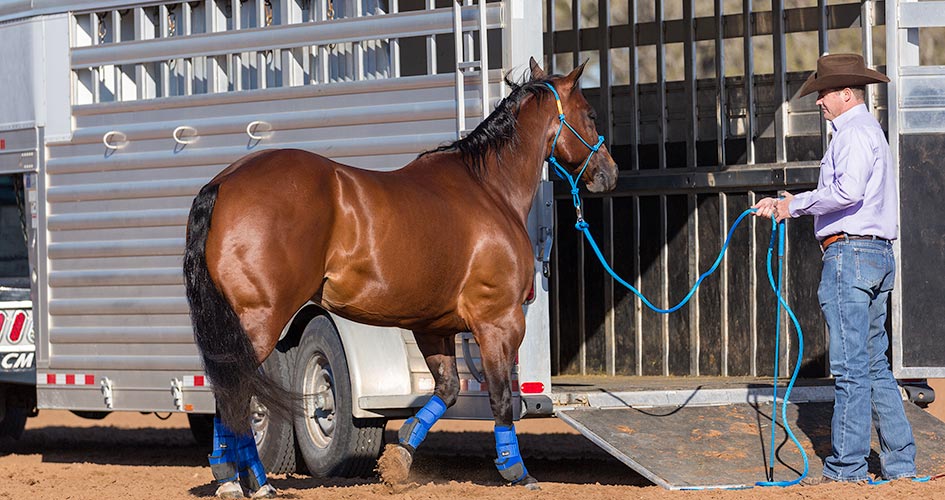
4. Getting the horse to load onto the trailer is nothing more than a game of cat-and-mouse using the Approach and Retreat Method. Approach and Retreat gives the horse a chance to build his confidence in the new object and situation.
Initially, just look for your horse to take a step or two on the ramp. Once your horse takes a step or two on the ramp, instead of forcing him to take another step onto it; do the complete opposite: Back him away from it. He’s expecting you to force the issue on him, so when you back him away from the trailer you’ll build his confidence.
Then ask him to step onto the ramp again. Each time you ask him to approach the ramp, see if you can get him to take another step onto it. Eventually, you want him going around you in a small circle. You want the horse to go around you in a small circle instead of doing the Sending Exercise because you want to work on one side of the brain at a time. (Remember, horses see, hear and think independently on each side of their brains.)
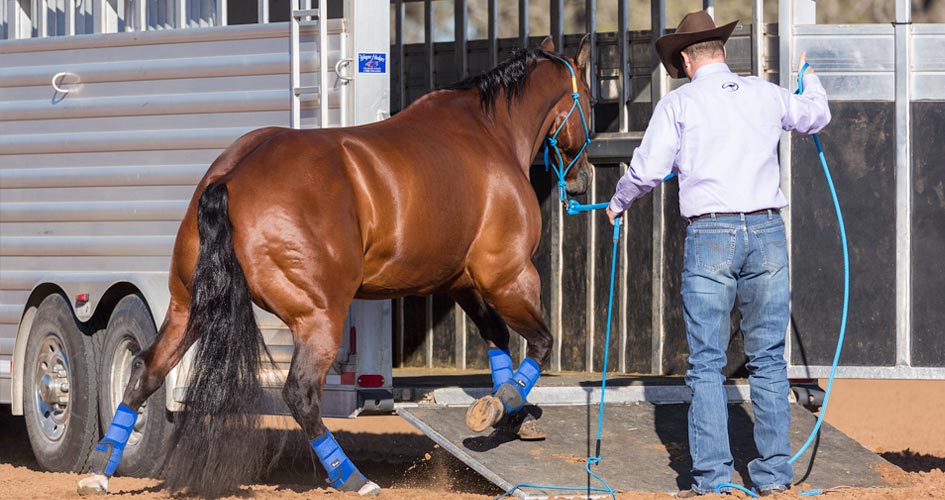
5. At first, the horse will probably rush over the ramp because he’s using the reactive side of his brain. Keep practicing and the horse will gain confidence and use the thinking side of his brain. You’ll notice that he’ll slow down and take his time.
Be aware that in an attempt to avoid the ramp, some horses will push into you and even try to run you over. Pay attention. If you see your horse invading your space, hold your Handy Stick up to block yourself, and, if necessary, tap the horse out of your space with the stick. If you don’t protect your space and instead move out of his way when he comes toward you, he’ll learn that he can avoid the ramp by running you over. Remember, with horses, whoever moves first loses. Don’t let it be you!
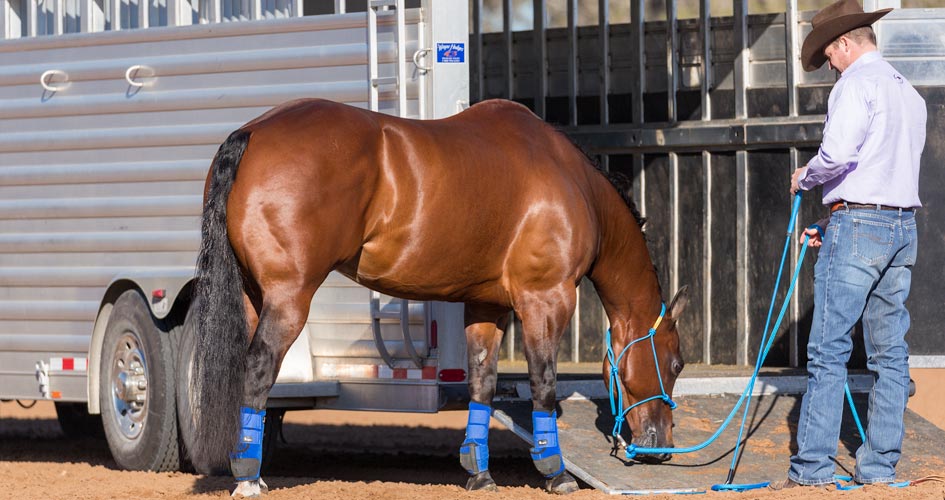
6. Any time the horse wants to stop and smell the ramp or paw at it, let him. That’s his way of performing his own “safety check.” If you don’t allow him to investigate the trailer, you’ll never be able to convince him to step onto it. He has to be 150 percent sure in his mind that the trailer is safe and not out to get him.

7. Get to the point where you can rub the horse with your Handy Stick while he rests on the ramp and relaxes. That’s the complete opposite of him rushing over it. You want him to realize that when he’s on it, he gets to rest and relax. When he’s not on it, he has to move his feet.

8. When the horse can calmly walk over the ramp on one side, switch sides and send him in a circle going in the opposite direction. Remember that when you switch sides, you need to start back at the beginning, using Approach and Retreat.
When the horse is confident about walking across the ramp in both directions, practice the Sending Exercise by sending him across the ramp in one direction and then yielding his hindquarters and sending him back across it from the other direction. You’re looking for him to confidently walk across the ramp and take his time.
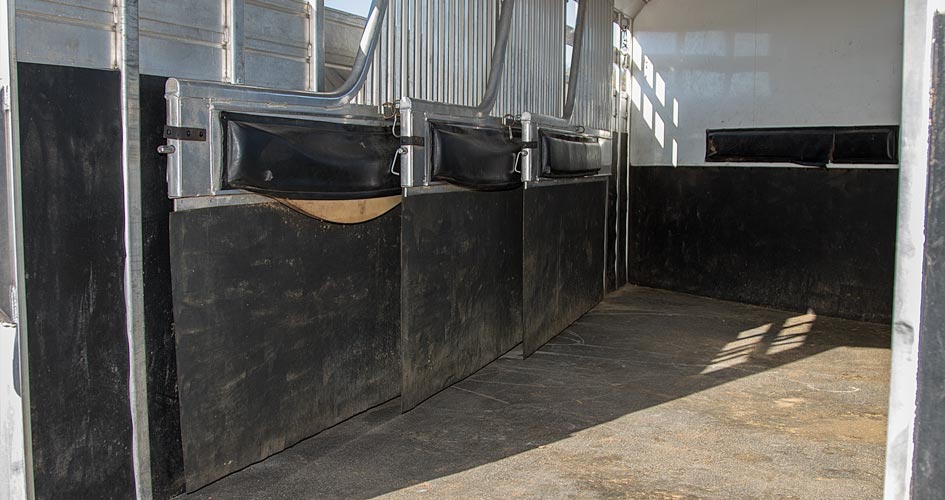
9. When the horse can calmly walk across the ramp in both directions, you’re ready to ask him to load onto the trailer. If your trailer has dividers in it, pull them to the side, if you’re able to, so that the horse will have more room. That will make him feel less trapped and claustrophobic.

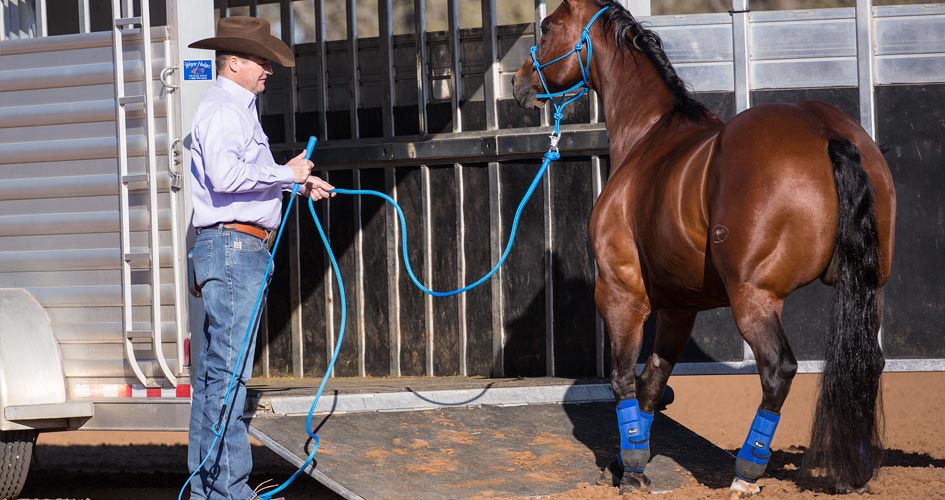
10. Using Approach and Retreat, look for the horse to take a step or two up onto the trailer, then back him away from it.
At this point, some horses will actually try to get all the way on the trailer, but I stop them from doing it. Before I let a horse get all the way on a trailer, I want to 9 be sure I can get him off it. There are plenty of horses out there that will willingly get on a trailer, but when you ask them to back off it, they freeze and refuse to move. So before letting a horse get all the way on the trailer and realizing you have a problem, be sure you can back him off it when he’s just got one foot on it. And then when he’s got two feet on it, etc.
When you are unloading a horse from a trailer, only let him back off it. Never let a horse get into the habit of turning around in a trailer and walking off it. If your horse is small and you’ve got a relatively big trailer, that’s not a big deal. But, for most horses, it creates a dangerous situation because they can get stuck trying to turn around in the trailer. Also, some horses get in such a hurry to get off the trailer that by the time you’ve undone the back door, they’re running you over to get out of it. Letting a horse get into the habit of turning around in a trailer and walking off it is just a really bad thing to let him do.
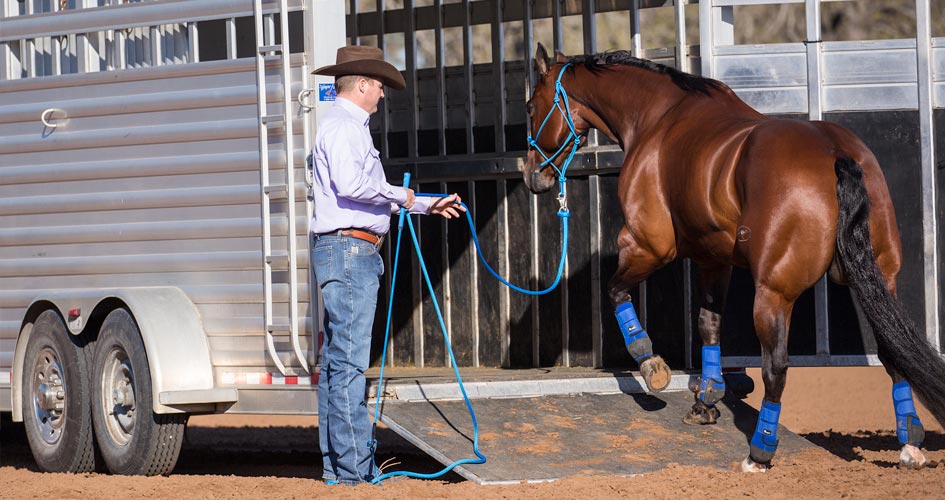
11. Then ask the horse to take a couple more steps onto the trailer and back him out of it.
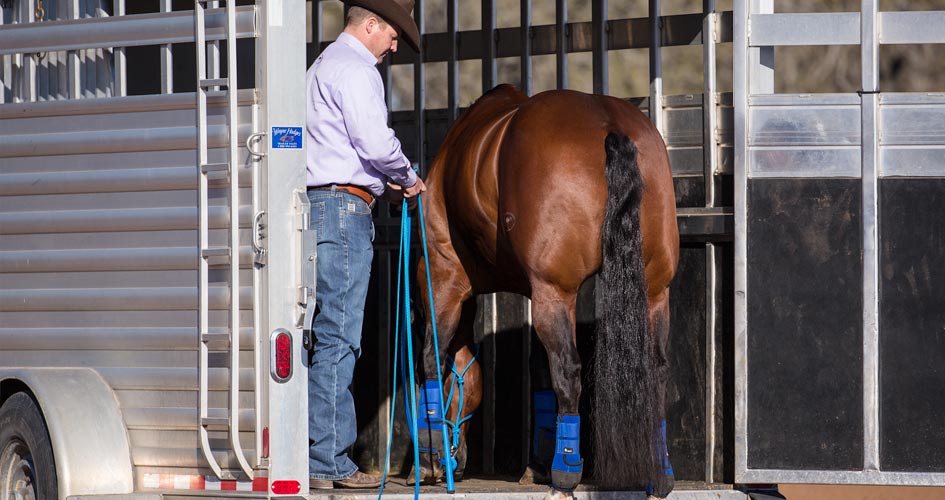
12. Each time you ask the horse to approach the trailer, ask him to take one more step onto it, until his whole body is in the trailer. Ideally, the horse should remain standing still until you tell him to back up, but a lot of horses will get nervous and start backing out of the trailer by themselves. If your horse does start backing up, turn his idea into your own and ask him to back up by wiggling your wrist and the lead rope. Once he’s off the ramp or out of the trailer, ask him to come forward and step onto the trailer again.

13. Then back the horse out of the trailer and take him away from it and let him rest and relax. This retreat gives the horse a chance to think about what just happened. You’ll find that a lot of horses will keep staring back at the trailer, wondering how they just escaped being trapped inside it. Most horses are so used to being forced onto trailers that when you retreat and take them away from the trailer, they can’t believe it. Every time you take a prey animal away from what he’s frightened of and he doesn’t get hurt, it builds his confidence.
When you back the horse off the trailer, be particular about backing him in a straight line. Horses get good at whatever you allow them to practice. So if you let your horse swing his hindquarters out to the side as you back him and he zigzags away from the trailer, that’s what he’ll learn to do. If you notice your horse backing crookedly, correct him by using the lead rope to pull his nose in the same direction his hindquarters are going. Then hold the Handy Stick horizontally and tap the rope to move his head and neck in the same direction his hips are going. It also helps to actually walk toward his hindquarters. For example, if the horse’s hindquarters are going to the left, pull his nose to the left and walk toward his left hip to straighten him up. When you pull the horse’s nose in the same direction his hindquarters are going, it ultimately straightens up his hindquarters.

14. Once the horse has rested a couple of minutes, practice loading him onto the trailer again. You’ll find that after giving the horse a break and a chance to think about the situation he’ll actually be more confident about stepping up onto the trailer. When your horse is in the trailer, rub on him with your hands or the Handy Stick. Let him know that being in the trailer is a good thing and nothing to fear.

15. Once you have the horse over his fear of the trailer, then you can work on getting him to “crave” the trailer—thinking that it’s the best place in the world. This technique not only works for getting your horse to willingly load in the trailer, but can be used if you have a horse that kicks, paws or gets nervous in the trailer. Horses develop all of these problems because they’d rather be outside the trailer than feeling like they’re trapped inside it.
By using a little reverse psychology, you’re going to show the horse that there’s no reason to get nervous or cop an attitude when he’s in the trailer because it’s the best place to be—he gets to rest and relax in it. On the other hand, being outside the trailer means nothing but hard work and sweat. Since horses are basically lazy creatures—they’ll always choose the option with the least amount of work involved—it won’t take the horse long to catch on to the lesson.
Outside of the trailer, put the horse’s feet to work. I prefer to use Lunging for Respect Stage Two and the Sending Exercise near the trailer, but as long as you make the horse hustle and work hard, you’ll accomplish the same goal. Keep in mind that this step only works if you really make the horse hustle his feet outside of the trailer. You have to give him a reason to want to be in the trailer.
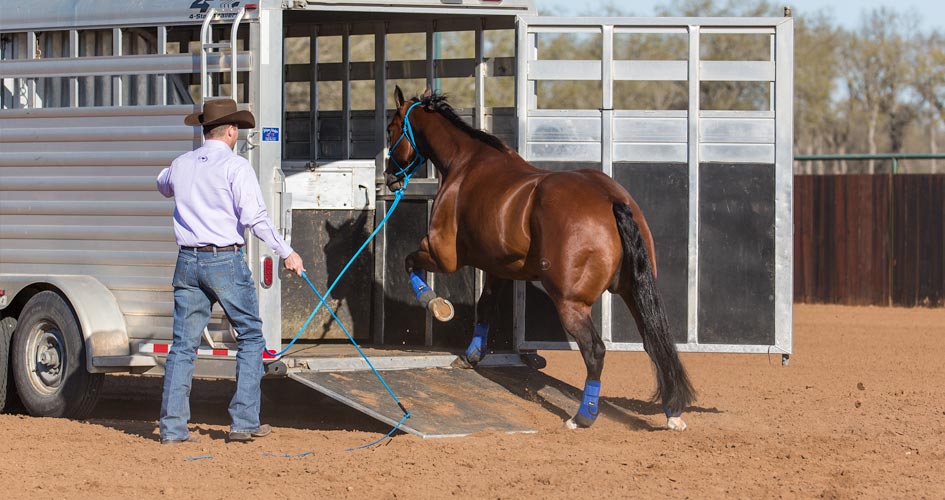
16. After working the horse for several minutes, give him the opportunity to rest in the trailer. At this point, the horse’s most valuable commodity is air. You’re showing him that the only place he gets to rest and get his air back is inside the trailer. Try to let the horse rest anywhere from five to 10 minutes in the trailer so that he has a chance to relax and think about the lesson.
After repeating this process several times in a row, you’ll notice that the horse will back off the trailer more slowly each time because he knows once he’s outside of the trailer he’s going to have to work hard. Eventually, you’ll have to practically beg the horse to step off the trailer—what I call a good problem to have.
Tying a Horse in the Trailer
I often get asked if it’s OK to tie a horse in the trailer using my rope halter. The answer is absolutely. I tie all my horses in the trailer using my halter and lead rope and an Aussie Tie Ring. Whenever you tie a horse using a rope halter, make sure the halter is positioned correctly. When you’re working with your horse, I tell you to position the halter so that the knots of the noseband are just above the soft tissue on his nose. When you tie a horse, you want the knots to sit higher on his face so that they’re about three finger widths above the pressure points on his nose.
You want the tie ring to be at eye level or higher to the horse. If it’s any lower, you risk the horse getting one of his front legs crossed over the lead rope.
Slip the lead rope through the tie ring so that’s it’s on the ring’s second setting. That way, the horse can’t easily pull out of it, but at the same time, if something did happen in the trailer where the horse got in a wreck with the lead rope, the rope could still slide through the ring and he’d be free.
You want about a foot of slack in the lead rope from where the clip attaches to the base of the halter to where the lead rope hooks on to the tie ring. That gives the horse room to move his head, but doesn’t create a dangerous situation where he can get his front feet hung up in the rope. When you tie a horse, a good rule to follow is “short and high.”
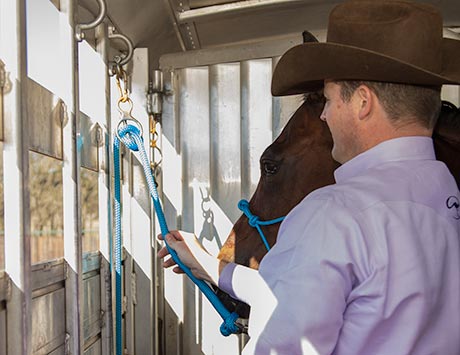
When tying horses in the trailer, I adjust the tie ring to the second setting, as shown here.
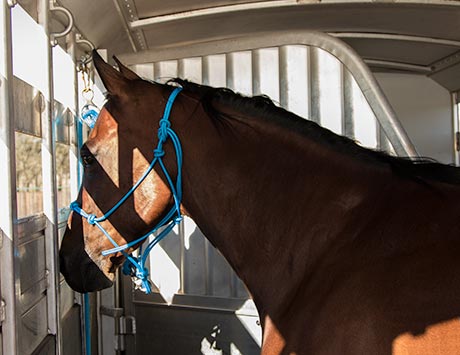
A good rule of thumb to follow when tying horses is “short and high.” You want the tie ring to be at or above the horse’s eye level and you want to leave about a foot of slack in the lead rope from the base of the halter to the tie ring.
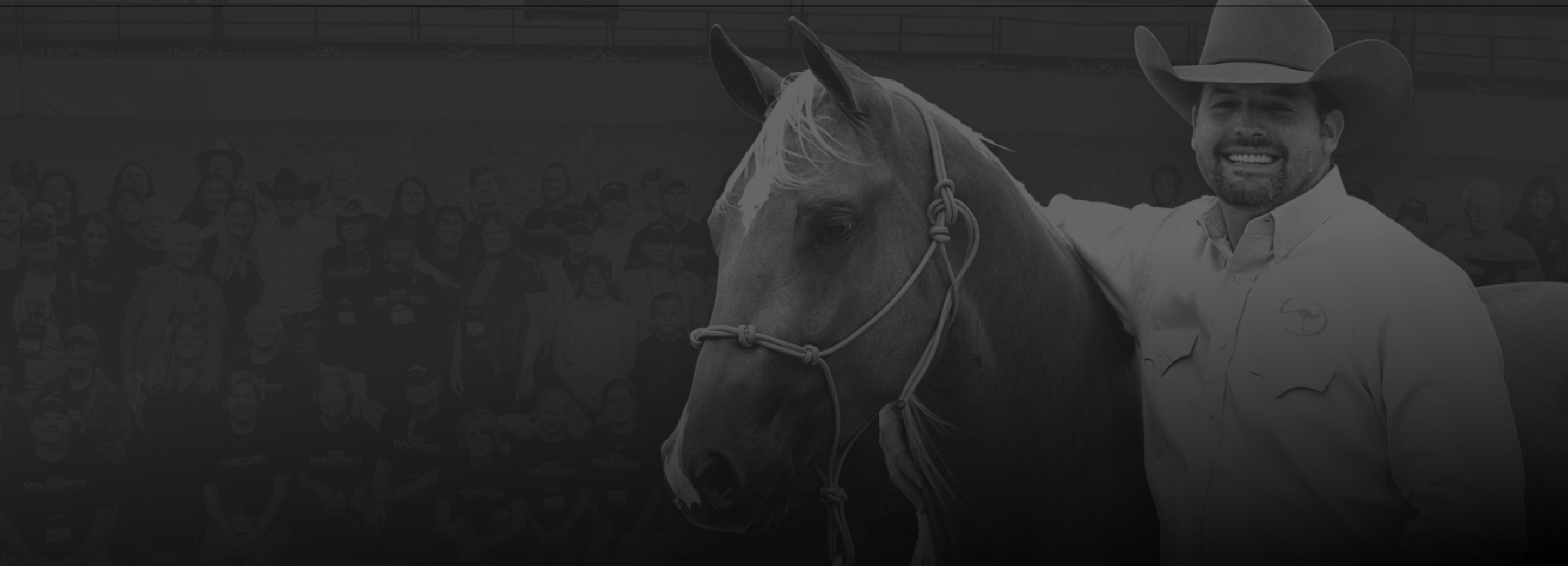
Want To Learn More? SIGN UP FOR OUR LOYALTY PROGRAM
Master your horsemanship training through Clinton’s step-by-step method videos by joining the No Worries Club today. Becoming a club member ensures you get VIP pricing on all of Clinton’s must-have training tools and resources. Plus, you’ll enjoy all the phenomenal benefits that come with club membership!



